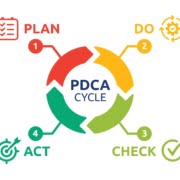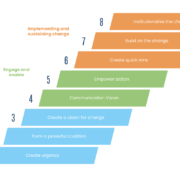Where to begin on your quality improvement journey in practice
Are you eager to do some quality improvements but find the sheer number of potential improvement opportunities overwhelming?
In this blog article, we’ll identify six key areas to begin your improvement project, complete with practical examples. By the end, you’ll feel confident and ready to embark on your journey.

Aligning with Strategy
When diving into your improvement project, remember that quality goes beyond the shop floor. Companies that value quality also have big-picture strategies that dictate where staff should be prioritising their time. If you want to get noticed by ‘higher-up’, align your project with your practice or company’s plan.
For instance, let’s take the practice’s goal to increase high-value procedure sales. Karen, a new nursing team leader, noticed her new employer isn’t doing as many dental X-rays as her previous practice, despite having all the equipment and a similar caseload. Karen teamed up with the practice manager to test a new pricing model that bundles together dental procedures and X-rays. She closely watched how this impacted sales.
Profit and Loss
Most organisations, including charities, are concerned with understanding their costs and how well they cover them with sales. So, any improvement project that targets these areas is a smart choice and is easy to demonstrate results. Don’t let financial metrics intimidate you; it’s all about finding ways to cut costs or sell more in the same time.
Consider Sally, the surgery nurse. She noticed that the practice was using costly 1ml syringes when the larger cheaper variety would do. She added clear signage to the drawers, encouraging her team to ‘think twice’ when grabbing a syringe. She monitors the number of syringes ordered and compares it to previous months.
Reducing Defects
In the veterinary world, “defects” can be seen as things that didn’t go as planned. A common example includes significant events, animal mortality, avoidable morbidity, and resulting client complaints. When these occur, the impact can be significant. A quality-driven team seizes this opportunity to investigate what went wrong in a blame-free environment and works on improvements to prevent such incidents from happening again.
For instance, consider Martin, the in-patient nurse. He takes over a shift and notices that a cat with an indwelling urinary catheter is in pain and the bladder isn’t draining properly. After the team resolve the situation, Martin conducts a root cause analysis with the team. Together, they develop a new standard operating procedure (SOP) for managing blocked cats, which involves doing an additional check on the bladder every 4hours.
Listening to the Voice of the Customer (VoC)
Maintaining a strong relationship with our customers is crucial in making sure our patients get the treatment we reccomend at home and also supporting the practice financially. Customers interpret quality in different ways so its important to research and understand what your customer value.
In the example above, Karen introduced a new pricing model, bundling all dental X-rays into dental procedures as a value-added package. After conducting a client survey, she found that some customers didn’t fully appreciate this change. In response, she piloted a new way of work in which the team sends the dental X-rays to the customer after the procedures in order for them to see what was done. She repeated the survey 6 months later.
Listening to the Voice of the Employee (VoE)
The practice team are close to the action and can provide valuable “bottom-up” perspectives on opportunities for improvement. But listening to all their suggestions and effectively managing their ideas is a skill in itself. It’s important to develop this skill to develop a culture of ‘continuous improvement’ amongst the team.
Consider Chloe, the practice manager. She regularly receives improvement requests from her staff but finds it challenging to handle them all. In a quality improvement effort, she created a closed suggestion box and provided template cards for her team to submit suggestions. On a monthly basis, she shortlisted the ideas that aligned with the practice’s strategy and presented them to the team for voting on the “quickest win.”
Pareto Principle (80/20 Rule)
The Pareto Principle, often referred to as the 80/20 rule, suggests that 80% of the effects come from 20% of causes. This principle is a valuable tool in quality management as even small or margin improvements in the 20% will result in substantial results.
Sandy, the receptionist, realises the team leaves the desk on average every 15 minutes. Half of the time they are going to the printer. She does an improvement project which moves the printer within safe reach of the desk. She compares the number of time the team leave the desk before and after.
Deciding the right opportunities to work on when you have so little time can be tough, but by using the above themes you can rationalise your decisions and get your project off to a confident start. These themes can also be used to help facilitate a meeting where you collect idea’s within the team.
If you need any support in making quality improvements, Contact VetQI—we’re here to help.





